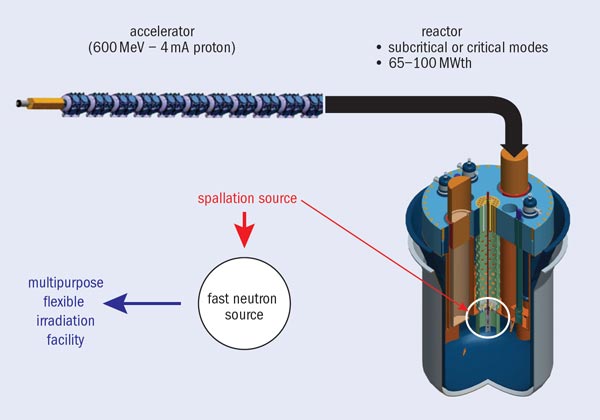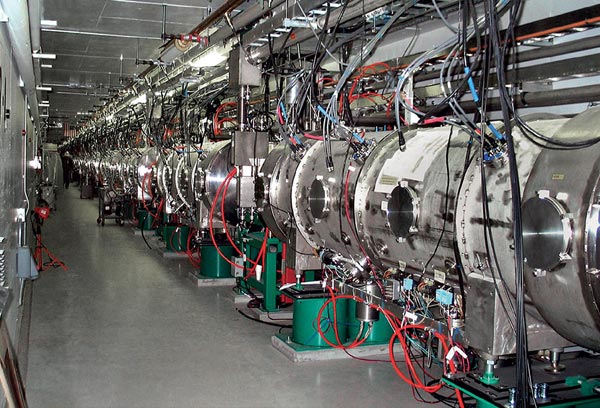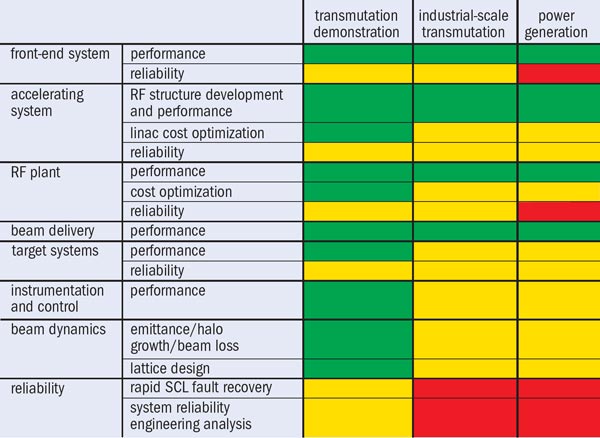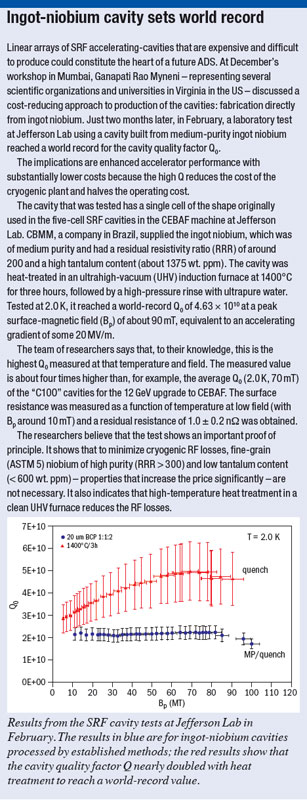A report from a workshop on accelerator-driven systems.
On 11–14 December, the city of Mumbai was the setting for the Second International Workshop on Accelerator Driven Sub-Critical Systems and Thorium Utilization. Only a month later, a team in Belgium announced the first successful operation of GUINEVERE, a prototype lead-cooled nuclear reactor driven by a particle accelerator – one of the milestones in progress towards the type of accelerator-driven system (ADS) envisioned in Mumbai.

Image credit: MYRRHA.
Today’s nuclear reactors are based on a core with fissile fuel configured such that neutrons emitted in the fission process can maintain a chain reaction. In an ADS, by contrast, the neutrons necessary to establish a sustainable fission chain reaction are knocked out of a spallation target by high-energy protons from an accelerator. Because these neutrons are produced externally from the core, an ADS reactor has a great deal of flexibility in the elements and isotopes that can be fissioned. Indeed, the ADS – long advocated by Nobel laureate Carlo Rubbia – is increasingly seen as offering promise for nuclear-waste transmutation and for generating electricity from thorium, uranium or spent nuclear fuel (Clements 2012).
Setting the scene
The Mumbai workshop attracted 160 researchers from nine countries to discuss developments in this burgeoning field. Srikumar Banerjee, chair of India’s Department of Atomic Energy, opened the workshop by welcoming all of the participants and providing an overview of India’s efforts in ADS research. He described several thrusts in the country’s R&D programmes: development of a low-energy (20 MeV) accelerator front end; design studies for a 1 GeV, 30 mA superconducting RF (SRF) linac; and development of a spallation neutron source. He also emphasized the importance of thorium in India’s three-phase, long-term development strategy for nuclear power, as well as the key role of the ADS concept both for power production and for management of minor actinides and used nuclear fuel.
Kumar Sinha, director of the Bhabha Atomic Research Centre (BARC) in Mumbai, which hosted the workshop, also spoke during the opening session. He discussed some of the challenges facing the ADS scientific community and stressed the value of international collaboration in large-scale projects of this kind, where it is important to co-ordinate efforts and optimize the use of financial and human resources.
The workshop convener, K C Mittal of BARC, outlined the overall context of the meeting – in particular the wish of India to exploit a thorium-based ADS to enhance the sustainability, safety and the proliferation resistance of nuclear-power generating systems. He noted that researchers worldwide have proposed innovative physics concepts and that several laboratories have succeeded in the design and construction of the new generation of accelerator required. Mittal underlined SRF accelerating technology and noted the potential importance of using ingot niobium for cost savings (see box). He also highlighted the continued ADS-related developments in India and China, at Belgium’s Multi-purpose hYbrid Research Reactor for High-tech Applications (MYRRHA) and for the European Spallation Source (ESS), which is being built in Lund, Sweden.

Image credit: ORNL.
Hamid Aït Abderrahim spoke about MYRRHA, the project to build a €960 million subcritical research reactor at the Belgian Nuclear Research Centre SCK•CEN (Studiecentrum voor Kernenergie, Centre d’Etude de l’é nergie Nuclé aire), which is scheduled to become operational in 2023. The centre is also the site of the GUINEVERE demonstration model, which is seen as a key step for developing procedures for regulating and controlling the operation of future subcritical reactors such as MYRRHA. The objectives for MYRRHA are to demonstrate the ADS concept at a significant power level and to prove the technical feasibility of transmuting minor actinides and long-lived fission products. Belgium welcomes international participation in the MYRRHA consortium, with eligibility based on a balanced in-cash/in-kind contribution to the project.
The technological advances for neutron spallation sources, such as the ESS, have obvious relevance for an ADS. Each type of facility requires a high-power, high-intensity linac to provide a proton beam for generating neutrons by spallation. A big difference, however, is the relative stringency of requirements for reliability, as measured by the rate at which faults trip the accelerator off-line. Colin Carlile reported on the outlook for ESS, noting that there are five spallation sources in four countries but, unlike the others, the ESS will produce neutrons in millisecond-scale bursts rather than on the microsecond scale. The linac will operate at 2.5 GeV, with 50 mA peak and 2 mA average current for 5 MW of proton-beam power with a 357 kJ/pulse. The ESS has 17 partners and expects to be the world’s best source of slow neutrons. They aim to begin producing neutrons in 2019.
The Spallation Neutron Source (SNS) at Oak Ridge National Laboratory in Tennessee in the US has an SRF proton linac that is sometimes seen as being close to a proof of principle for an ADS accelerator. The SNS now has two years of experience at the megawatt level, having reached 1 MW within three years of operation. John Galambos of Oak Ridge summarized information on SNS operation that is pertinent to an ADS. He said that initial proton experiments indicate a favourable beam loss for an ADS and that although the SNS was never designed for low trip rates, the declining trip rate seems encouraging. Data from 2008, which are still considered current and applicable, indicate that four of the world’s neutron facilities have roughly similar performance: many tens of trips a day lasting more than a minute, with far fewer than one trip a day lasting more than three hours.

Not all of ADS approaches call for SRF linacs. Swapan Chattopadhyay of the Cockcroft Institute in the UK told workshop participants about research into an ADS using a novel fixed-field, alternating-gradient driver. Collaborators in this effort represent PSI in Switzerland, Fermilab in the US, the International Atomic Energy Agency in Vienna, the Japan Proton Accelerator Research Complex, MYRRHA, ESS and BARC. In Japan itself, meanwhile, efforts are focusing on SRF, as Akira Yamamoto of KEK explained – but overlap with R&D for a future International Linear Collider and for energy-recovering linacs. KEK foresees building an in-house SRF fabrication and test facility.
As of early 2012, no government-funded ADS initiatives for nuclear-waste disposal or power generation are underway in the US. Nevertheless many of the country’s scientists and engineers are actively working in ADS-related efforts. Two high-power accelerators, both built by Jefferson Lab, already operate with SRF technology: the SNS at Oak Ridge and Jefferson Lab’s own Continuous Electron Beam Accelerator Facility (CEBAF). A third project, the SRF-based Project X, is in the design and prototyping stage at Fermilab and is foreseen to serve several scientific purposes with 3 GeV, 3 MW protons.
CEBAF pioneered the large-scale application of SRF when it became operational for nuclear-physics experiments in the mid-1990s at 4 GeV. It progressed to operate at 6 GeV and 1 MW through incremental improvements in technology. Researchers there have sought to reduce RF trips and develop tools to characterize them. A consortium of Virginia universities, industrial partners and Jefferson Lab has been established to pursue ADS R&D while preparing to host an ADS facility.
The efforts of the Virginia consortium fall in line with the sentiments of the September 2010 white paper written by 13 scientists from laboratories in the US and Europe, which was published by the US Department of Energy’s Office of Science: ‘Accelerator and Target Technology for Accelerator Driven Transmutation and Energy Production’ (Aït Abderrahim et al. 2010). The paper notes that many of the key technologies required for industrial-scale transmutation requiring tens of megawatts of beam power, including front-end systems and accelerating systems, have already been demonstrated. The report also points out, however, that demonstration is still required for other components, such as those that enable improved beam quality and halo control, as well as highly reliable subsystems.

At Mumbai, an informal international collaboration to attack these and other ADS challenges continued to coalesce. Participants recognized the magnitude of the challenges that must be overcome for an ADS scheme to be completely successful: well thought-out, long-term development plans and international collaboration are going to be indispensable for its realization. One of the strengths of the workshop was that it gathered experts from the various subfields relevant to an ADS and gave them the opportunity to discuss the different struggles that they each face while still achieving optimization for the overall system. With this in mind, participants decided to meet again next year for a third International Workshop on Accelerator Driven Sub-Critical Systems, probably in Europe.





